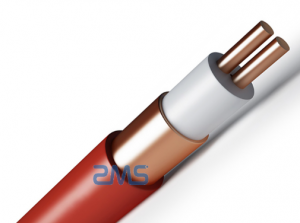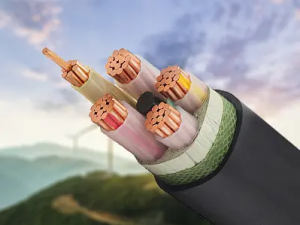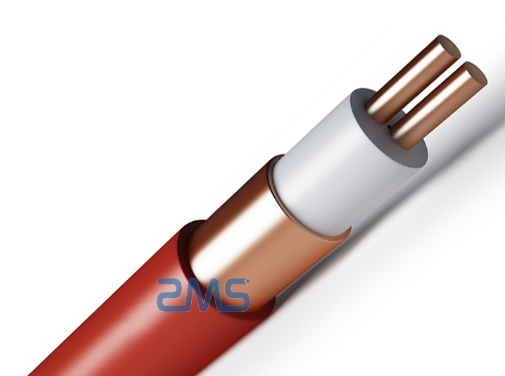Mineral insulated cable is what cable mineral insulated cable is referred to as MI cable, used as wiring, the domestic custom is called magnesium oxide cable or fireproof cable.
It is by the mineral material magnesium oxide powder as insulation copper core copper sheath cable, mineral insulated cable by the copper conductor, magnesium oxide, copper sheath of two inorganic materials.
Mineral insulation cable composition MICC cable is a cable with annealed copper as a conductor, dense magnesium oxide as insulation, and annealed copper tube as a sheath.
If necessary, outside the annealed copper sheath extrusion wrapped a layer of plastic outer sheath, special requirements for smoke-free and halogen-free occasions can be added outside a layer of low-smoke halogen-free sheath.
Advantages of Mineral Insulated Cable
Fire-resistant
The two materials used in the mineral-insulated cable, copper and magnesium oxide, are inorganic.
This cable will not burn, nor will it contribute to combustion, and can continue to operate near flame.
The copper sheath melts at 1083 °C, while the magnesium oxide insulation material cures at, 2800 °C.
High Operating Temperature
Mineral-insulated cables can withstand continuous operation at temperatures up to 250 °C.
However, in emergencies, the cable can continue to operate at temperatures close to the melting point of the copper sheath for short periods.

Long Life Span
The inorganic materials applied in mineral-insulated cables ensure stability, long life, and fire resistance.
Explosion Resistance
The highly compacted insulation in mineral-insulated cables prevents the passage of vapors, gases, and flames between the parts of the equipment connected to the cable.
Small Outer Diameter
The diameter of mineral-insulated cables is smaller than other cables with the same current rating.
Waterproof
Mineral-insulation cables can continue to operate if they are completely submerged in water with the help of their seamless metal sheath.
High mechanical strength
MICC cables are robust and can withstand severe mechanical damage without compromising their electrical properties.
High Load Capacity
For the same cross-section, mineral-insulated cables carry higher currents than other types of cables. At the same time, mineral-insulated cables can withstand considerable overloads.
Grounding
For metal-insulated cables, a separate grounding conductor is not required, as the copper sheath used in this cable already acts as a grounding conductor and provides an excellent low grounding resistance.
For grounded sheath circuit (ESR) wiring, the outer copper sheath can be used as a ground and neutral conductor in MEN (multiple ground neutral) systems.
High Corrosion Resistance
The copper sheath of mineral-insulated cables is highly resistant to corrosion and for most installations, it does not require additional protection measures.
Where the copper sheath of the cable is susceptible to chemical corrosion or heavy industrial contamination, the mineral-insulated cable should be protected with a plastic sheath.
Mineral Insulated Cable Type
Common mineral cables are BTTZ, NG-A, BTLY, YTTW, BBTRZ, and other models, and are divided into flexible MICC cables and rigid mineral insulated cables.
So what are the uses of these mineral-insulated cables?
BTLY, YTTW, BBTRZ, etc. belong to flexible mineral insulated cable, while BTTZ belongs to rigid mineral insulated cable, so let’s take a look at their uses!
Flexible mineral insulated bbtrz cable
The main material consists of mineral compounds, with high-temperature resistance, fire, explosion-proof characteristics, not easy to burn, can work under the flame temperature of 950 °C 1000V, the conductor structure is also relatively soft, easy to bend, applicable to a variety of laying methods.
Flexible mineral-insulated yttw cable
The yttw cable is composed of a copper core conductor as well as a layer protective sheath, it is a new type of fireproof cable, the cable also has a fireproof layer on the outside, so the fireproof performance is also high.
There are flexible, high-pressure resistance characteristics in addition to the characteristics of not being suitable for moisture, easy to lay, and widely used in basic industrial and civil construction.
Flexible mineral insulated btly cable
Mineral btly cable is composed of metallic copper and magnesium oxide powder, as the melting point of copper is 1083℃, and the melting point of magnesium chloride is 2800℃, so the cable itself will not cause fire, nor will it help to ignite.
The working temperature can reach 1000℃, with the characteristics of fire resistance, waterproof, corrosion resistance, long life, safety, high-temperature resistance, etc.
Suitable for special grade buildings, first-class buildings and super high-rise buildings should use mineral insulated cables.
Rigid mineral-insulated bttz cable
BTTZ is a rigid mineral insulated cable, all composed of inorganic materials, so there is no insulation aging, with has high-temperature resistance, is fireproof, explosion-proof, non-combustible, with high load capacity, small outer diameter, high mechanical strength, long service life, and other characteristics.
Normal working temperature can reach 250℃, with high fireproof performance, widely used in nuclear power plants, metallurgy, airports, high-rise buildings, and other places.
Mineral Cable Usage
MICC cables are widely used in nuclear power plants, metallurgy, chemical industry, mines, aerospace, high-rise buildings, airports, terminals, underground railways, and other places with concentrated passenger flow, to protect the fire pumps, fire elevators, important loads, emergency evacuation instructions, as well as anti-smoke systems and other important fire-fighting equipment with electricity.
Once installed and laid, mineral cables can be used forever.
Mineral cable is composed of high conductivity copper conductor, mineral (magnesium oxide) insulation material, and seamless copper tube sheath, when the cable is used for copper corrosion occasions, the outer layer of another layer of corrosion protection outer sheath.
Mineral cable has the advantages of being fireproof, waterproof and explosion-proof, non-combustible, smokeless, non-toxic, and fire-resistant.

Low-smoke halogen-free cable and mineral-insulated cable are two different kinds of cables.
The following cable treasure to share with you the low smoke halogen-free cable and mineral insulated cable from the material, characteristics, voltage, and use of the comparison.
Cable Material Distinction
Low smoke halogen-free cable: halogen-free (F, Cl, Br, I, At) does not contain lead and other environmental substances of the rubber insulation.
Mineral insulated cable: magnesium oxide (inorganic material) sheath and metal wire core between a layer of tightly compacted magnesium oxide insulation layer.
Cable Performance Characteristics
Low smoke and halogen-free cable: no halogen gas is released during combustion, low smoke concentration, and the permitted working temperature is up to 150℃, and the cable achieves the effect of negative combustion through irradiation cross-linking process, which is in line with the national standard of environmental protection cable.
Mineral insulated cable: will not burn, will not help combustion, does not produce harmful gases, in the flame temperature of 1000 ℃ can maintain normal power for 3 hours, strong electrical stability, long life, load capacity large.
Different rated voltage and usage of cables
Low smoke and halogen-free cable: suitable for rated voltage 450/750V and below, with halogen-free, low smoke, flame retardant requirements and high safety and environmental protection requirements of places. Such as high-rise buildings, stations, subways, airports, hospitals, libraries, family homes, hotels, hospitals, office buildings, schools, shopping malls, and other crowded places.
Mineral insulated cable: suitable for rated voltage 0.6/1KV and below, with flame retardant, fire, soft requirements, and high-temperature requirements of the place. Such as petrochemical, airports, tunnels, ships, offshore oil platforms, aerospace, steel metallurgy, shopping centers, parking lots, and other occasions.
